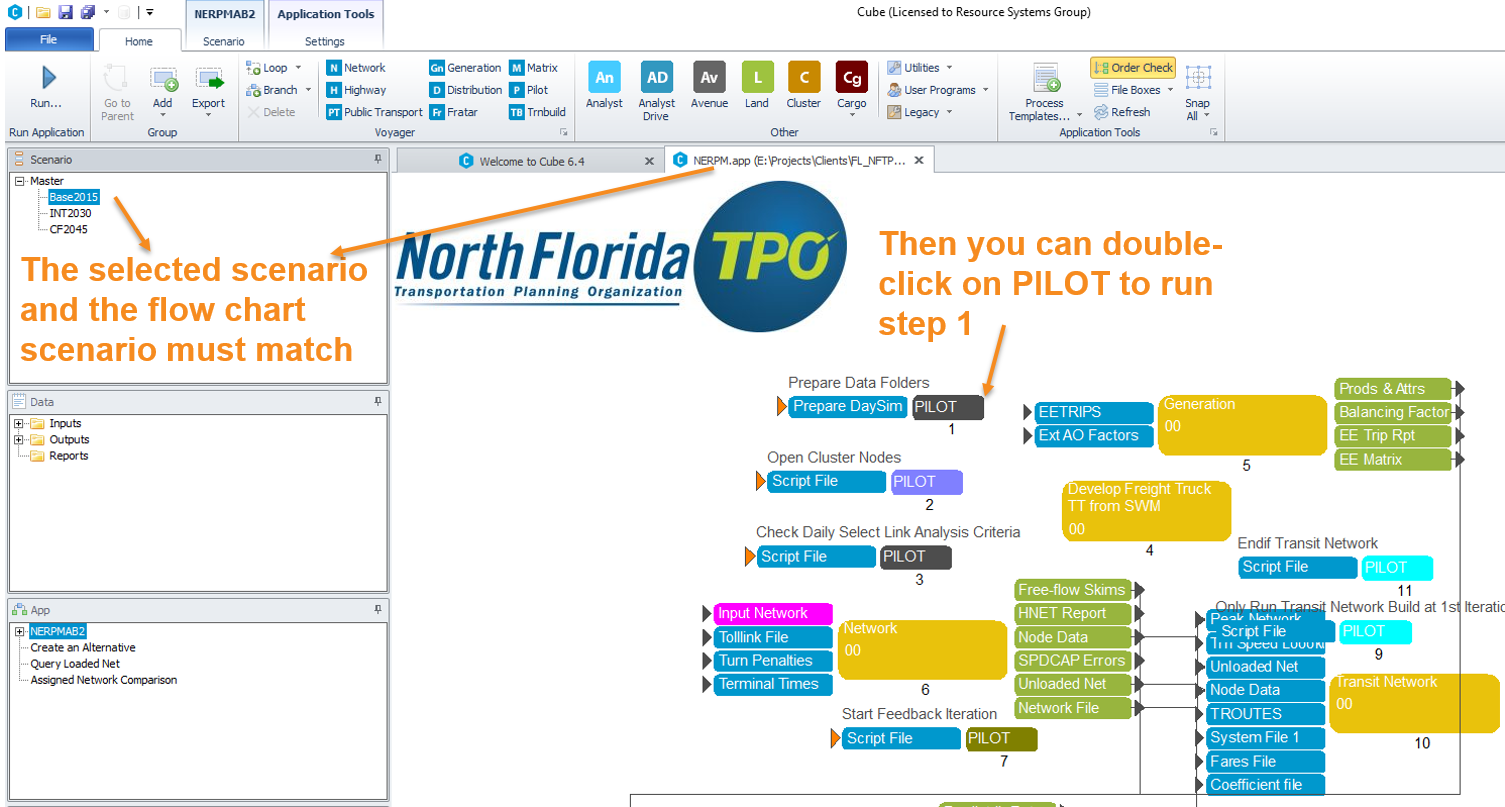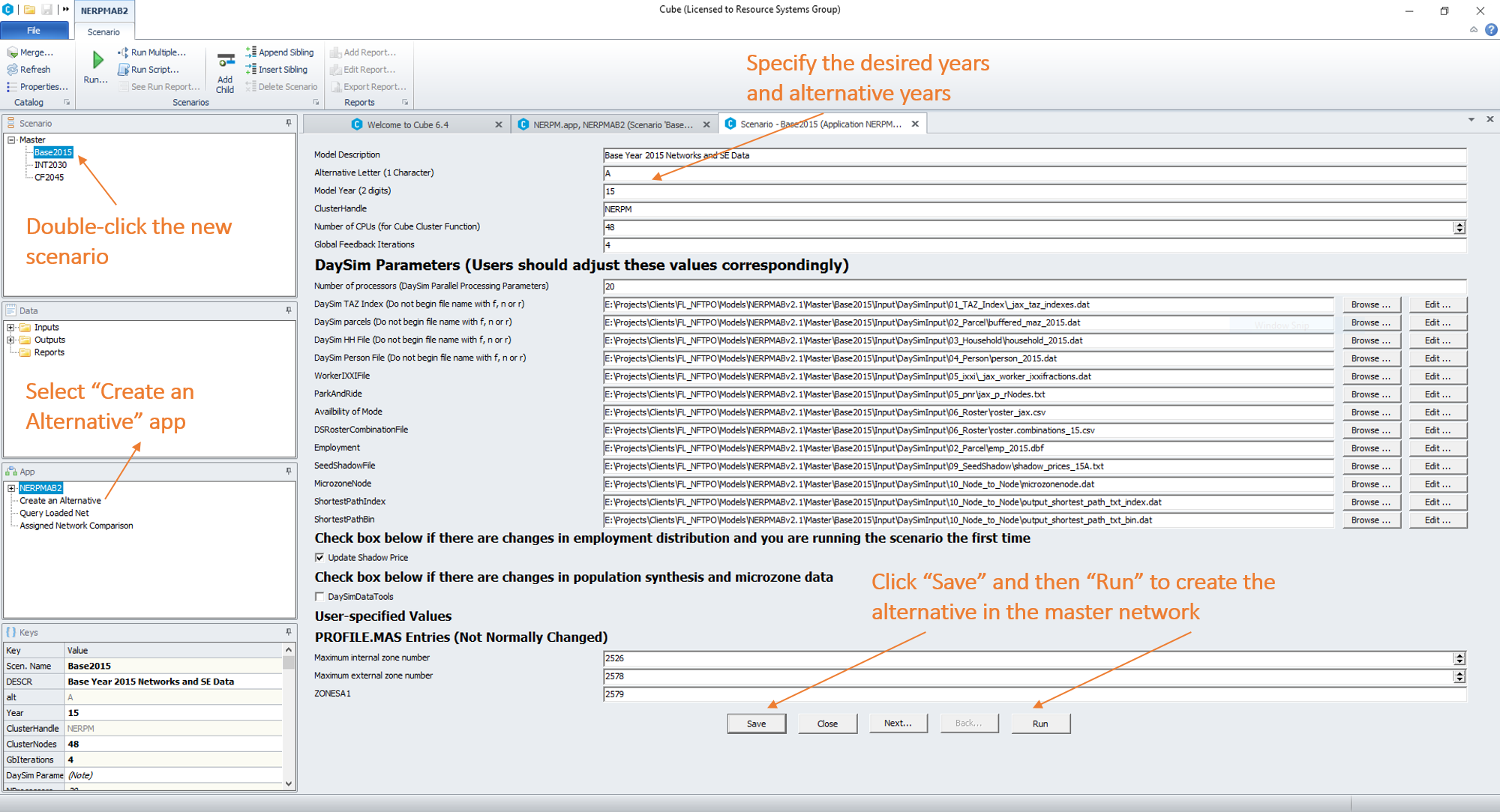Difference between revisions of "6.3 Creating a New Scenario"
m (Changed Base2010 to Base2015) |
|||
| Line 6: | Line 6: | ||
children of the Master. A child may be considered as a variation on its parent. | children of the Master. A child may be considered as a variation on its parent. | ||
You can also create children of the preexisting scenarios, such as | You can also create children of the preexisting scenarios, such as | ||
| − | + | Base2015.</p> | |
<p>A child scenario will inherit key values from its parent. For example, a | <p>A child scenario will inherit key values from its parent. For example, a | ||
catalog may have some keys, one of which is named “Year.” This may be set to 10 | catalog may have some keys, one of which is named “Year.” This may be set to 10 | ||
| − | in the | + | in the Base2015 scenario. If a new scenario “New Road” is created as a child of |
| − | the | + | the Base2015, then the new scenario will also initially have a value of 10 for |
the Year key. You may then edit the “New Road” scenario, updating the value of | the Year key. You may then edit the “New Road” scenario, updating the value of | ||
Year to 15. You may choose to update some of the other keys of the scenario, or | Year to 15. You may choose to update some of the other keys of the scenario, or | ||
| − | you can leave them the same as in the | + | you can leave them the same as in the Base2015. Running the “New Road” scenario |
will substitute the value of 15 into the application for the Year key, giving | will substitute the value of 15 into the application for the Year key, giving | ||
new results and providing a comparison with the base situation.</p> | new results and providing a comparison with the base situation.</p> | ||
| Line 58: | Line 58: | ||
Cube will actually create the scenario as a new child of the parent scenario of | Cube will actually create the scenario as a new child of the parent scenario of | ||
CF2040, inheriting the parent’s settings (Master in this case). Any new child | CF2040, inheriting the parent’s settings (Master in this case). Any new child | ||
| − | of Master will be identical to | + | of Master will be identical to Base2015, and if another year is desired then |
the appropriate network, land use, and key value inputs with need to be added | the appropriate network, land use, and key value inputs with need to be added | ||
to the scenario manually. The inheritance process will be applied to any | to the scenario manually. The inheritance process will be applied to any | ||
Latest revision as of 19:52, 2 February 2021
The NERPM-AB catalog has a Master scenario, and scenarios are hierarchical in nature. From the Master, you can create scenarios that will appear as children of the Master. A child may be considered as a variation on its parent. You can also create children of the preexisting scenarios, such as Base2015.
A child scenario will inherit key values from its parent. For example, a catalog may have some keys, one of which is named “Year.” This may be set to 10 in the Base2015 scenario. If a new scenario “New Road” is created as a child of the Base2015, then the new scenario will also initially have a value of 10 for the Year key. You may then edit the “New Road” scenario, updating the value of Year to 15. You may choose to update some of the other keys of the scenario, or you can leave them the same as in the Base2015. Running the “New Road” scenario will substitute the value of 15 into the application for the Year key, giving new results and providing a comparison with the base situation.
• To add a child scenario, click Add Child on the Scenario ribbon tab. Or, right-click under Scenario in Scenario Manager and choose Add Child.
An Edit Box opens where you type the name of the new child scenario. To cancel the operation, press ESC. To complete and save the name entered, press ENTER.
After the name is entered, the Scenario Properties dialog is displayed to allow entry of the scenario code, and then the Edit Scenario dialog will also be displayed. This allows entry of the key values for the new scenario. An additional modification has been made to NERPM-AB so that the first step of the model process is to copy all of the input files from the parent scenario in the child’s input directory.
If modifications need to be made to the scenario inputs before running the new scenario, then the Prepare Data Folders step can be run manually to copy the inputs. First, the NERPMAB1 App flow chart should be visible with the new scenario active as shown in Figure 6-1. If the new scenario is not active, it can be activated by selecting a different scenario and selecting the new scenario again. Then the "Prepare Data Folders" step can be run by itself by double-clicking on that PILOT step pointed to in the following image. The input files will be copied and can then be edited using the standard Cube tools.
Figure 6-1 App Flow Chart
One important consideration when creating new scenarios is that Cube always copies the key values from the parent of the new scenario. This is the case even if the scenario is created as a "sibling" of an existing scenario. For example, if the new scenario is created as a sibling of CF2040, Cube will actually create the scenario as a new child of the parent scenario of CF2040, inheriting the parent’s settings (Master in this case). Any new child of Master will be identical to Base2015, and if another year is desired then the appropriate network, land use, and key value inputs with need to be added to the scenario manually. The inheritance process will be applied to any scenario created as a child of one of the existing scenarios in that all inputs and key values will be inherited from the parent. Any scenario specific changes for the new scenario need to be applied after creating the scenario and running the Prepare Data Folders step.
Create a Master Network Alternative
If roadway network changes are needed for the new scenario, or a new year is being used, then a new alternative should be created in the Master network. This is needed because NERPM-AB uses a single master net file for all scenarios. The network alternative is specified by the scenario key values for Alt and Year. The Create an Alternative app in NERPM-AB can be used to create the needed alternative specific fields in the master network. Care must be taken in modifying the network to avoid making unintentional changes to other alternatives. Additionally, several files in the scenario input directory include the Year and Alt in their file name, so the names must correspond with the scenario Alt and Year keys.
Follow these steps (as illustrated in Figure 6-2)
- Select the Create an Alternative app in the App section of the scenario manager
- Double-click on the scenario for which you want to create a new network alternative
- Specify the key values for the new and existing alternative letters and years
- WARNING: If the new alternative letter and year correspond to an existing alternative in the master network, then they will be replaced running this app.
- Click on the Save button and then the Run button to create the alternative
- Click on the Close button to exit Create an Alternative
- Select the NERPMAB1 app in the App section to return to the main model
Figure 6-2 Steps in Creating a New Scenario

